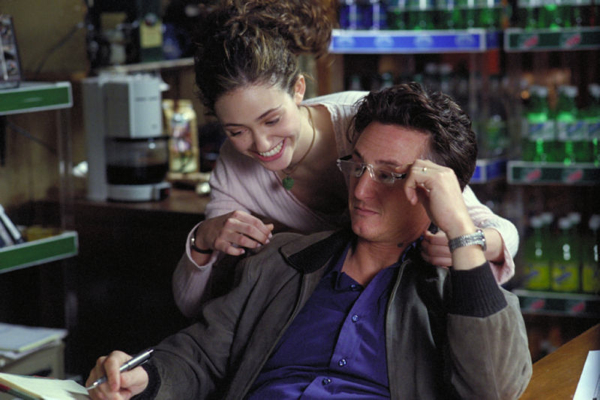Movie review by Greg Carlson
“Mystic River,” Clint Eastwood’s adaptation of the Dennis Lehane novel, is certain to receive at least a handful of important nominations come award season. Selected to kick off the New York Film Festival, Eastwood’s movie is a careful, meditative study of loss and pain so somber and grim the entire experience is reminiscent of the way a cold, rainy day can dredge up forgotten memories of long-ago regret. Set in the tough neighborhoods of blue-collar Irish Boston, “Mystic River” demonstrates total confidence in its milieu, and for that the audience is rewarded.
Focusing on a trio of long-estranged childhood friends who find themselves linked together in middle age by a terrible crime, “Mystic River” is part police procedural, part art film. Sean Penn, in another of his smoldering performances, is Jimmy, an ex-con and all around hard case who has settled with some uncertainty into partial respectability as the owner of the local corner store. Dave (Tim Robbins) is now married to Celeste (Marcia Gay Harden), but still suffers from the unspeakable childhood trauma of being kidnapped and molested by two men posing as cops. Sean (Kevin Bacon) has mostly left the old neighborhood, but returns as a police detective with his partner Whitey (Laurence Fishburne) to investigate a homicide.
It turns out that Jimmy’s beautiful teenage daughter Katie (Emily Rossum) has been murdered, her beaten body discovered in a park. Eastwood takes his time throughout this early exposition, and the result is an almost unbearable timeline in which the bad news methodically snakes its way from the discovery of the body by the authorities to Jimmy’s unsuspecting family, celebrating the first communion of one of Katie’s younger siblings. The whole sequence showcases Eastwood’s talent for pacing, and is complemented by Penn’s own tonal shifts, from father’s worry at his daughter not showing up for an important event, to eventual anguish at the knowledge that she is gone forever.
Eastwood, directing from a script by Brian Helgeland, balances and attenuates the level of audience privilege. At times we are trusted (perhaps tormented) with awful knowledge that other characters do not have, but the identity of Katie’s killer is as mysterious to us as it is to Sean and Whitey. The plot provides us with two compelling suspects: Dave, who not only saw Katie just before she disappeared, but also arrived home the night of the murder covered in blood and nearly incoherent, and Brendan (Thomas Guiry), Katie’s boyfriend, who was planning to elope with her to Las Vegas.
While “Mystic River” remains ultimately committed to the narrative conventions that Eastwood sees as critical to his respect for the audience, the filmmaker also masterfully plays with notions of truth versus the willingness to accept something as truth. Eastwood knows that people are capable of a wide, shaded range of identifying characteristics: it is even possible to harbor good and evil simultaneously. Early on, Jimmy calmly explains that he intends to find the person responsible for Katie’s murder, and we are both comforted and horrified by the conviction of that statement. By the time the final scene of “Mystic River” unfolds – a stunning set-piece that gathers the main characters together at a parade – Eastwood has left us with much to ponder, and much to mourn.
